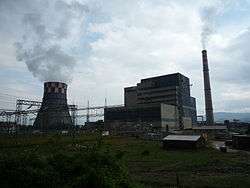Gacko
| Gacko Гацко | |
|---|---|
|
View on Gacko | |
 Location of Gacko within Bosnia and Herzegovina | |
| Coordinates: 43°10′N 18°32′E / 43.167°N 18.533°E | |
| Country | Bosnia and Herzegovina |
| Entity | Republika Srpska |
| Government | |
| • Mayor | Milan Radmilović (SDS) |
| Area | |
| • Total | 735.88 km2 (284.12 sq mi) |
| Population (2013 census) | |
| • Total | 9,734 |
| Time zone | CET (UTC+1) |
| • Summer (DST) | CEST (UTC+2) |
| Area code(s) | 59 |
Gacko (Serbian Cyrillic: Гацко) is a town and municipality in East Herzegovina in the Republika Srpska entity of Bosnia and Herzegovina.
Geography
The municipality covers an area of 736 km2 (284 sq mi), making it one of the larger municipalities in Bosnia and Herzegovina.
The town is near the state border with Montenegro.
History
Middle Ages
In the Middle Ages, the town was the seat of a župa (county) of Serbia under the Nemanjić dynasty. In 1276, Serbian prince Stefan Dragutin defeated his father Stefan Uroš I on the Gacko field and took the throne. Gacko was at this time an important commercial centre on the Dubrovnik–Foča route. In the 14th century the region was governed by the powerful Vojinović family.[1] In 1359, veliki čelnik Dimitrije held the region.[2] In its turbulent history, Gacko often changed rulers: after the fall of the Serbian Empire, Gacko became part of the Kingdom of Bosnia, and by 1483–85 it had been annexed by the Ottoman Empire into the Sanjak of Herzegovina.
Ottoman period
The burning of Saint Sava's remains after the Banat Uprising provoked the Serbs in other regions to revolt against the Ottomans.[3] Grdan, the vojvoda of Nikšić, organized revolt with Serbian Patriarch Jovan Kantul. In 1596, the uprising broke out in Bjelopavlići, then spread to Drobnjaci, Nikšić, Piva and Gacko (see Serb Uprising of 1596–97). The rebels were defeated at the field of Gacko. It ultimately failed due to lack of foreign support.[4]
Modern history
Austro-Hungarian authorities took it over in 1878, a decision which was made at the Berlin Congress. In 1908, Austria-Hungary annexed Bosnia and Herzegovina sparking the Bosnian crisis which eventually led to World War I. After that war, Gacko joined the State of Serbs, Croats and Slovenes, going onto to the Kingdom of Serbs, Croats and Slovenes by the end of 1918. These were the first incarnations of Yugoslavia where Gacko remained until Bosnia and Herzegovina declared independence in 1992. The town largely stayed out of the Bosnian war thanks to its geographical position and early forced removal of the Bosnian Muslim population. Since the peace deals at the end of that conflict, Gacko has remained within the Republika Srpska entity.
Settlements of Gacko
Avtovac • Bahori • Bašići • Berušica • Brajićevići • Branilovići • Cernica • Čemerno • Danići • Dobrelji • Domrke • Donja Bodežišta • Dramešina • Dražljevo • Drugovići • Dubljevići • Fojnica • Gacko • Gareva • Gornja Bodežišta • Gračanica • Gradina • Hodinići • Igri • Izgori • Jabuka • Jasenik • Jugovići • Kazanci • Ključ • Kokorina • Kravarevo • Kula • Lipnik • Lončari • Luka • Lukovice • Ljeskov Dub • Medanići • Međuljići • Mekavci • Melečići • Miholjače • Mjedenik • Mrđenovići • Muhovići • Nadinići • Novi Dulići • Platice • Poda • Pridvorica • Pržine • Ravni • Rudo Polje • Samobor • Slivlja • Soderi • Srđevići • Stambelići • Stari Dulići • Stepen • Stolac • Šipovica • Šumići • Ulinje • Višnjevo • Vratkovići • Vrba • Zagradci • Zurovići • Žanjevica
Economy

There is a thermoelectric powerplant in the municipality, which is the main employer. The Czech power company ČEZ intends to build a new power plant.
Sport
The local football club, FK Mladost Gacko, plays in the First League of the Republika Srpska.
Notable people
- Admir Ćatović, footballer
- Nemanja Supić, footballer
- Saša Starović, volleyball player
- Sanja Starović, female volleyball player
- Vukašin Višnjevac, football coach
- Dušan Bajević, footballer and football coach
- Vule Avdalović, basketball player
- Nemanja Gordić, basketball player
- Vuk Drašković, writer and politician
- Bogdan Zimonjić, Orthodox priest and voivode (military commander)
- Blagoje Adžić, general JNA
- Aleksa Buha, philosopher and politician
| Census year | Total | Serbs | Muslims | Croats | Yugoslavs | Others |
|---|---|---|---|---|---|---|
| | ||||||
| 1991 | 10,788 | 6,661 (61.74%) | 3,858 (35.76%) | 29 (0.26%) | 84 (0.77%) | 156 (1.44%) |
| 1981 | 10,279 | 6,215 (60.46%) | 3,424 (33.31%) | 21 (0.20%) | 346 (3.36%) | 273 (2.65%) |
| 1971 | 12,033 | 7,634 (63.44%) | 4,184 (34.77%) | 15 (0.12%) | 20 (0.16%) | 180 (1.49%) |
| | ||||||
| 1991 | 4,584 | 2,253 (49,15%) | 2,144 (46,77%) | 28 | 78 | 81 |
See also
References
- ↑ Fine, John Van Antwerp, Jr. (1994). The Late Medieval Balkans: A Critical Survey from the Late Twelfth Century to the Ottoman Conquest. University of Michigan Press. p. 53. ISBN 978-0-472-08260-5.
- ↑ SANU (1908). Glas. 78–80. SANU. p. 196.
- ↑ Bataković 1996, p. 33.
- ↑ Ćorović, Vladimir (2001) [1997]. "Преокрет у држању Срба". Историја српског народа (in Serbian). Belgrade: Јанус.
Bibliography
- Bataković, Dušan T. (1996). The Serbs of Bosnia & Herzegovina: History and Politics. Dialogue Association.
External links
| Wikimedia Commons has media related to Gacko. |
- http://www.gacko-rs.info
- http://www.virtualnahercegovina.com/index.php/vijesti/gacko
- http://www.gacko.net
Coordinates: 43°10′N 18°32′E / 43.167°N 18.533°E
_(9545994489).jpg)